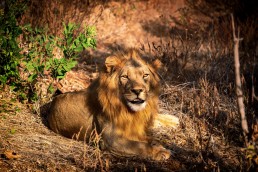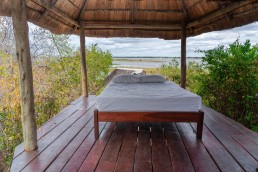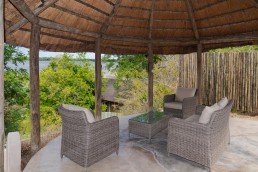Self-Drive or All-Inclusive Safari in Lower Zambezi National Park? Check Tips for Both!
As overlanders, we tend to choose self-drive safaris over guided safaris, usually due to both freedom and costs. However, when we know that wildlife sightings and thus photo opportunities will be considerably better on a guided safari, we’ll happily upgrade the choice. Lower Zambezi National Park is one of those few national parks that are best explored on all-inclusive luxury safaris. Read on to learn why – and how to pick the best safari lodges, campsites, and game drive areas in Lower Zambezi.
Characteristics of Lower Zambezi National Park
Lower Zambezi is remote and pristine: it’s known for its unfenced luxury camps, supreme wildlife sightings, and trail-blazing conservation successes. The national park is sandwiched between the gently flowing Zambezi River and drastic Muchinga escarpment, both act as a perfect backdrop for wildlife photography.
Imagine massive elephant herds crossing lush riverine landscape right by your private deck. Then picture exclusive lion and leopard sightings on game drives, where your car might be the only one exploring the winterthorn woodlands and floodplains framed by mopane trees, both trees elephants’ favorite feeding grounds.
We’ve had the best canoe safari experience in Lower Zambezi, and we’ll never forget our first – and last – time catching and releasing a huge tiger fish. Safaris in Lower Zambezi National Park packs in a variety of memorable experiences in just a couple of days!
What Are the Differences Between Lower Zambezi National Park and Lower Zambezi GMA?
Lower Zambezi National Park is surrounded by a huge buffer zone called Lower Zambezi Game Management Area. There are no fences, so wildlife can move freely between the park and GMA, although GMA is dotted with villages, banana plantations, and farms.
Lower Zambezi GMA is enormous: almost 20 000 km2, whereas the national park area is 4 092 km2 (still huge). Generally, the game drives are better inside the national park if you’re looking for unspoilt wilderness and relaxed wildlife sightings – but you can also score great sightings in GMA nearby the borders of the national park.

Why Guided Game Drives are Better Than Self-Drives in Lower Zambezi National Park?
If you’re doing self-drives, you’re forced to overnight in Lower Zambezi GMA (Game Management Area) and outside Lower Zambezi National Park, because there are no campsites nor self-catering lodges inside the park – only all-inclusive safari lodges.
Don’t get me wrong, some camps and campsites right outside the gates are stunning and there can be great sightings in the game management area. But, when you venture inside the park, it’s a long drive from the gate to the most wildlife-rich areas, especially if you don’t know where to go.
On your own and without a radio connection to guides, you end up losing precious time and exploring areas where you don’t have many chances to see for example the lions, leopards, and wild dogs.
In Lower Zambezi, some of the animals are more skittish than in South Luangwa. For example, the leopards that we found in Lower Zambezi were extremely cautious. Without a keen eye and correct approach, you won’t score great sightings. That’s why a professional safari guide – and a great spotter – become a real advantage.
If you’re into wildlife photography, it’s also such a luxury to concentrate on your craft instead of driving, spotting the animals, and maneuvering the car to the best possible angle for photos. When you have more time for the footage, it really shows. Fewer game drives can provide better photos!
How to Choose the Best Safari Lodges in Lower Zambezi National Park?
When choosing the best safari lodge, you are choosing the most suitable safari experience for your own needs. So, list your own preferences first to map out what you’re ideally looking for in a safari lodge.
Here are some of the questions that you should think about before searching for the best safari lodges in Lower Zambezi:
- Are you looking for guided game drives and the best guides available?
- Would you prefer a private game drive vehicle with a guide and a spotter to find the animals on your wish list and concentrate on wildlife photography on your own terms?
- Do you prefer a luxury safari or more simple and affordable accommodation? Would you like to stay in a tented camp or a safari lodge with chalets? Would you love to get a riverfront suite for the relaxing views and best wildlife encounters from the privacy of your own room? Do you need wifi during the safari holiday, or would you like to indulge in spa treatments? What about a private plunge pool or multi-course gourmet meals?
- On top of game drives, would you like to do canoe safaris, hikes, cultural tours, sunset cruises, or go tiger fishing on Zambezi River? Many lodges offer versatile activities within Lower Zambezi but not all of them. It pays to pick the lodge according to your own interests.
- Would you like to give back to the community and support wildlife conservation? Some lodges support the work of Conservation Lower Zambezi and local communities, making it possible to visit CSL headquarters (like we did, check our interview with them here) or local villages to enrich your safari experience.
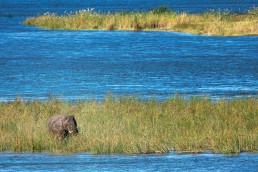
Why We Chose Royal Zambezi Lodge Over the Other Safari Lodges in Lower Zambezi
We have visited Lower Zambezi already in 2015 when we fell in love with one particularly special luxury safari lodge: Royal Zambezi. We wanted to repeat the blissful safari experience because Royal Zambezi has remained throughout the years as one of our happy places. After over 10 African countries, Royal is still among the best safari lodges that we’ve ever visited.
The activities at Royal Zambezi Lodge have had a special place in our hearts: the guide and spotter that we had there in 2015 were spectacular and canoe safari on the Zambezi River out of this world experience.
So, for us, the choice was even too easy: returning to Royal Zambezi Lodge felt a divine idea that gave us hope through tough situations with the Defender. Our 2-night stay in Lower Zambezi was as splendid as it was back in 2015, although the lion and leopard sightings were even better this time!
What Animals You Can See in the Lower Zambezi Lodges and Camps
Elephants love to roam by the Zambezi River and are often seen from the riverside lodges, even crossing through properties. During our both stays in Royal Zambezi Lodge, elephants visited the camp. Both times we were able to observe the elephants from our private deck and take some cool photos.
Elephants, waterbucks, and buffalos like to cross into Zambezi’s seasonal islands, which can be seen from many riverside lodges. Hippos are easy to see in the river, so staying by the river will add hippo sightings, and possibly also crocs, to your leisure time on a safari. Add to that many colorful birds and impressive raptors: a cry of the fish eagle often echoes upon the valley floor.
Activities in Lower Zambezi
- Morning and afternoon game drives in Lower Zambezi National Park and adjoining GMA
- Night game drive with spotlights
- Walking safaris
- River safaris and sunset cruises
- Canoe safaris in Lower Zambezi National Park
- Tiger fishing on Zambezi River
- Village tours in Lower Zambezi Game Management Area
- Hiking to the nearby mountains for sweeping views over the Zambezi Valley and Zambezi River (outside the hottest months, June-August)
Birding (on a game drive, walking safari, boat safari, canoeing, etc) - Bush breakfast and lunch, dinner on a private island, etc – and of course daily sundowners in the bush on game drives!
- Spa treatments
…and more depending on your chosen safari lodge
How Are the Game Drives in Lower Zambezi National Park?
Game drive experience depends on many things: are you self-driving, joining a group morning or afternoon drive, or are you having your private safari vehicle with a guide? When looking for the best results, we definitely recommend the latter.
Generally, a basic 2- to 3-hour shared game drive can feel short in Lower Zambezi because the distances to the best game drive areas are long from the gate. Especially, if you wish to see leopards or wild dogs! When you’re staying at a luxury lodge and have your own guide and spotter, they can tailor the game drive according to your preferences.
If you’re sharing the vehicle, you must consider others’ needs. The guide tries to accommodate everyone’s wishes resulting in always kind of compromise. If you want to track the big cats at dawn but someone else prefers to photograph birds against the sunrise, the game drive will include a bit of both. Sometimes you’re lucky to find the great sightings at a fraction of time but usually, you need to focus on the desired result, which makes group game drives frustrating if you have a special goal in mind. Also, if you’re into photography, you usually like to linger longer at great sightings, which isn’t possible on a group game drive.
One game drive inside Lower Zambezi National Park is never enough. Plan having at least 2 to 3 game drives inside the park for great sightings and experiencing the versatile ecosystem. If you have more time, you can also opt to do game drives also in the GMA, where we had some great elephant, buffalo, and lion sightings. For landscapes, leopards, and wild dogs, the park is the best place to explore.
Wildlife Species in Lower Zambezi National Park & GMA
Currently, 4 out of “Big Five” species can be found in Lower Zambezi: elephant, lion, leopard, and buffalo. Good news: soon you can score the whole Big Five, as Conservation Lower Zambezi and the Department of National Parks and Wildlife (DNPW) are planning to reintroduce black rhino black to the ecosystem.
Spotting Big 4 animals is easy within the national park: we scored them all within just 2 days on our last visit and within 3 days on our previous visit. Of course, you always need luck: it’s a game!
Due to the Zambezi River, hippos and crocs are so plentiful that the sightings can be guaranteed. Other species found in Lower Zambezi National Park include, but are not limited to, kudu, zebra, impala, baboon, hyena, jackal, civet, genet, porcupine, and honey badger – the latter four mostly spotted on night game drives.

River Cruises and Canoe Safaris in Lower Zambezi
If you have to pick only one activity outside game drives, go with the canoe safari! Canoeing offers a totally different angle for photography and it’s a meditative way to spend an afternoon in the bush. We’ve done it twice with Royal Zambezi now: their guides are great at spotting all the different species on the shores and in water.
We’ve had close encounters with elephants and hippos from the canoe – and thanks to professional guides, we always felt safe. I was also impressed how the guides were able to allow the best angles for photography while paddling: we got some nice bird photos, as well!
From the water, we also watched impalas, buffalos, baboons, crocs, and monitor lizards. The spotted bird species included malachite kingfisher, pied kingfisher, gray-headed kingfisher, fish eagle, ibises, egrets, Egyptian geese, African skimmer (our first spotting), African jacana, and many bee-eaters (at least little bee-eater, white-fronted bee-eater, and carmine bee-eater).
Birding in Lower Zambezi
There are more than 350 bird species, so it’s only fair to declare Lower Zambezi as birder’s paradise. There are various kingfishers (also giant, woodland, and brown-hooded kingfishers are common to compliment my canoe safari listing above), eagles, vultures, herons, darters, storks, cormorants, egrets – you get the vibe.
Some of the sought-after bird species include African pitta, Narina trogon, Lilian’s lovebird, Pel’s fishing owl, palm-nut vulture, Blue-cheeked bee-eater, and Angola pitta.
The best time for birding is generally the wet season, although Lower Zambezi is an excellent birding destination around the year.
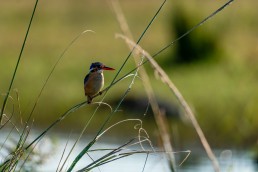
Visiting Lower Zambezi National Park: All You Need to Know When Planning a Safari
Lower Zambezi National Park Fees & Practicalities
Lower Zambezi entrance fee per person per day is $30 for self-drives (conservation fee) and $25 per person per day if you’re doing game drives with a lodge (the prices in Lower Zambezi and South Luangwa are the same). Zambia has the same policy in all national parks, so when self-driving, the entrance fee is slightly higher.
The national park fees in Lower Zambezi, and in Zambia in general, are valid for a day (6 AM to 6 PM, not for 24-hour period (as in Tanzania, for example).
The entrance fee for a foreign-registered car is $15 per day (GVM under 3000 kg). When visiting Lower Zambezi National Park on self-drive, make sure that you’ve calculated right all the national park fees.
If you book an activity – canoeing boating, or angling – that takes place inside the national park, you need to pay relating activity fees, as well. For example, canoeing costs $20 per person on top of national park fees, and you have to pay the fees of the boat taking you to the channel.
Luxury Safari in Lower Zambezi
If you can afford the splurge, a luxury safari is the best way to experience Lower Zambezi National Park and as described above, staying at Royal Zambezi Lodge will rejuvenate your soul. There are also other luxury lodges inside the park (Royal lies slightly outside park boundary which we saw as an advantage: if on some days you’d like to explore the GMA area on a game drive or walking safari, you don’t have to pay the national park fees).
Camping in Lower Zambezi GMA (Area Surrounding LZ National Park)
On our way, we checked a couple of campsites and for us, one was clearly above all: Wood’s Camp. You can park right at the water’s edge if you wish, views are beautiful, showers are warm, ablutions are clean, and the bar is nice.
Camping in Wood’s Camp is also a bargain: $8 per car/tent per night as opposed to, for example, more popular Mvuu Lodge & Campsite, where camping costs $25 per person. Mvuu has private ablutions but only a couple of riverfront campsites. We preferred the view and atmosphere at Wood’s Camp.
Budget Accommodation and Self-Catering in Lower Zambezi
Our pick for self-catering accommodation in Lower Zambezi GMA is Muchichili Safari House nearby Wood’s Camp. Muchichili is a bargain for bigger groups, as it can accommodate up to 10 people and the daily rate starts from $395. You’ll have a lovely private holiday house with stunning river views and a private cook (all activities and meals except breakfast are extra).
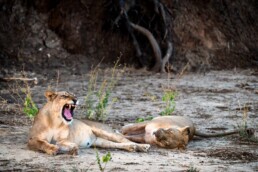
Best Time to Visit Lower Zambezi National Park
The dry season in Lower Zambezi runs from May to October and the tropical wet season from November to April. Generally, the dry season is better for wildlife viewing, but like always, it depends on your preferences and holiday timing. The wet season is the best time for birding and it’s also calving season meaning loads of cute baby animals!
Green season (rainy season) brings tempting discounted rates for luxury lodges and the scenery is stunning with green bush bursting in wildflowers. Rainy season means frequent afternoon storms and heavy showers, but also hot summer weather. November and April are both generally good times to visit Lower Zambezi with only occasional afternoon showers.
Please note that some lodges are only open seasonally during the dry and shoulder season (March/April to November). Royal Zambezi Lodge stays open all-year-round.
If you’re also visiting Victoria Falls, then May–September will be the best timing for your safari in Zambia. Tiger fishing is at its best in September and October.
Fly-in Safari, Road Transfers from the Camp, or Self-Drive?
Lower Zambezi used to be a high-end fly-in safari destination for years, but nowadays it’s risen to the radar of overlanders and self-drive safaris, as well.
Fly-in safari is the easiest and most hassle-free option. Both scheduled and charter flights are available, and the return flight is usually included in the prices of luxury lodges.
Driving from Lusaka to Lower Zambezi National Park (T2 through Kafue)
Some lodges offer road transport from Lusaka to Lower Zambezi, when the shuttle drives through Chirundu. The tar road (T2) from Lusaka to Chirundu through Kafue is decent all the way and rather a quick drive (2,5–4 hours depending on the truck traffic and from which side of Lusaka you’ll start). From Chirundu, it’s gravel and dirt road towards to gate of Lower Zambezi National Park. Some lodges offer also boat transfers.
If you’re self-driving from Lusaka to Lower Zambezi, the same route (T2 through Kafue and Chirundu) is easiest.
The leg from Chirundu to Chongwe gate of Lower Zambezi National Park and doable without 4×4 at least in the dry season, although high clearance is recommended and you must know how to tackle sand and uneven terrain at places. Usually, 4×4 is strongly recommended to tourists.
Please note that between Chirundu and Lower Zambezi National Park there is no network coverage outside villages, virtually no road signs (except to the lodges) and you may encounter wild animals, including elephants, on the road.
Maps.me shows the correct track from Chirundu to Chongwe Gate (Lower Zambezi National Park) but currently Google Maps doesn’t know the route. If you don’t have Maps.me, upload the app, it’s free. Otherwise, ask detailed driving instructions from your lodge or campsite. You can also look for the signs to Mvuu and Muchichili lodges, as they have done the best signage. After Mvuu Lodge, just continue straight until you’ll reach your accommodation (ask other cars directions if needed).
There’s also a fun 4×4 route from Lusaka to Lower Zambezi through Leopard Hills, which we recommend if you have a capable four-wheeler: the landscape is beautiful and some steep inclines, declines, and hairpin bends make it an interesting outing.
When we drove the Leopard Hills route in June 2021, it was slowly being graded by the Chinese, so maybe someday it’ll be tar at least for the first half from Lusaka.
Driving from Mana Pools (Zimbabwe) to Lower Zambezi National Park
Some lodges can also offer pick-ups from Kariba in Zimbabwe or Chirundu (the nearest town in Zambia after you’ve crossed the border).
Driving from Luangwa to Lower Zambezi (for 4×4 enthusiasts wanting to cross the Lower Zambezi National Park)
Some overlanders and self-drivers with a capable 4×4 vehicle also cross Lower Zambezi National Park on their own, but it’s not recommended unless you’re self-sufficient and have the needed recovery gear. We were planning that route but didn’t have enough time for it. Ask for directions and road conditions on DriveZam Facebook group if you’re interested in taking that route!
Royal Zambezi Lodge kindly offered us a 2-night stay in their gorgeous camp in Lower Zambezi but, as always, all opinions remain our own.


